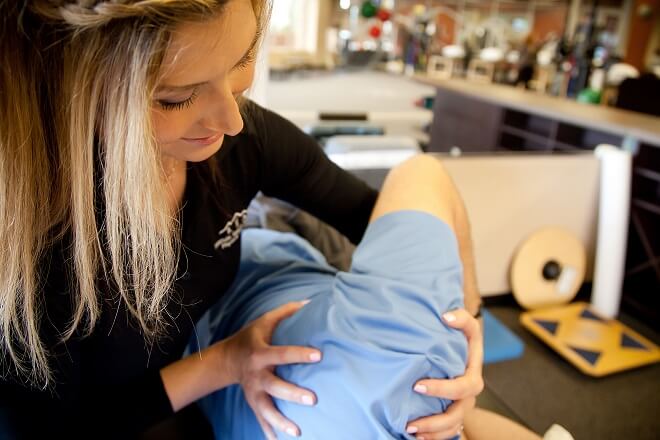So you’ve been having knee pain for a while, and you’re considering physical therapy. What should you expect when you go for your first appointment?

In honor of National Physical Therapy Month, let’s take a look at some things to consider as you start therapy:
Before you even walk through the door, fill out as much of the paperwork as you can.
Your doctor will forward on any tests or diagnoses made at her clinic, notes Bethany Urquidez, a physical therapist at Foothills Sports Medicine Physical Therapy (a Physiquality network member in Arizona). However, your PT will have specific questions about how your body feels and moves, as well as needing the typical insurance paperwork. A lot of physical therapy clinics will have all the required paperwork posted to their website, making it easy to fill out before you arrive for your first appointment.

Be prepared to take a survey about how you feel or where you feel pain.
At a Physiquality member clinic, you may be asked to take a survey about your level of function. The survey is part of the PTPN Outcomes Program (PTPN is Physiquality’s parent company) and helps you and your therapist set goals and track your progress in therapy. You may be asked to take this short survey at the beginning, middle and end of therapy.
Consider making notes about your concerns or questions.
Before you leave for the therapy office, jot down the major concerns and questions you may have about therapy, recommends Mitch Kaye, a physical therapist and the Director of Quality Assurance for PTPN. This will come in handy if you forget some of your thoughts in the midst of your appointment.

Know what to expect when it comes to payment.
When choosing a therapy practice, be sure to check with both the office and your insurance company about your insurance coverage, the office’s participation in your insurance, and your copayments or other out-of-pocket costs. Mitch says it’s worth your while to make a phone call or two to find this out in advance of your first appointment to avoid any surprises when you arrive. Some offices, like Foothills, will run a benefits check for you, so you don’t have to deal with the insurance company, so it’s a good idea to check with the office first.
Before you leave the house, think about what you’re wearing to physical therapy.
Bethany suggests thinking about the part of your body that will be evaluated by the physical therapist. If your knee is being treated, for example, try to wear shorts. If it’s your back or neck, wear a shirt without a collar. And if it’s your shoulder, think about a loose-fitting shirt or even a tank top. These types of clothing will make it easier for the PT to see and evaluate the joint or body part in question.

Be prepared for some questions. A lot of questions.
Once you’ve given the people at the front desk your paperwork and walked into the treatment area of the clinic, the PT will ask you a number of questions. This doesn’t mean that the therapist didn’t review your chart, says Mitch. This is the physical therapist doing the first part of her evaluation, determining what exactly might be causing your pain and how best to treat it. And keep in mind that a PT’s evaluation is different from an evaluation your doctor may have done.
The evaluation will also most likely include manipulation or movement of the joint in question, to see what types of positions or movements cause discomfort or pain, as well as tests to consider your gait (i.e., how you walk and move), your endurance (how far you can walk without getting out of breath), and your strength. All of these tests will point toward ways to strengthen muscles and improve function, as well as reducing your pain.

Learn about your plan of care — what your therapy appointments will be like over the next several weeks.
Once the therapist considers the causes of your pain and ways to treat it, the two of you should have a conversation about how your therapy will progress. This may also include discussion of your treatment outcomes, i.e., how long it might take to get you back to your daily activity goals. Using the data from the PTPN Outcomes Program, your therapist can discuss the average length of time a patient will take to improve for your condition. It’s never a guarantee, says Mitch — every patient is different — but it will give you an estimate of how long you might be in physical therapy.
Prepare to do “homework,” i.e., a home exercise plan.
Finally, the physical therapist will most likely give you some exercises to do at home on a regular basis. These will help you continue to improve in between the appointments at the clinic. It’s a part of working with your PT towards the same goal — to get you functioning better in the least amount of time and treatments.
Are you looking for a physical therapist for your first treatment? Use our locator below to find a Physiquality physical therapist near you.
Physiquality.
- Why is physical therapy important after a joint replacement? February 6, 2019.
- If you’re in pain, try physical therapy before relying on painkillers. April 9, 2018.
- Choosing a physical therapist that measures outcomes. March 17, 2015.
- Celebrating PT Month: Why you should see a physical therapist. October 17, 2011.
Urquidez, Bethany. For the first-timer: What to expect at your first visit. Foothills Sports Medicine Physical Therapy.
American Physical Therapy Association.
- Preparing for your visit with a physical therapist.
- Understanding payment for physical therapy services.
“Notebook” by waferboard is licensed under CC BY 2.0.